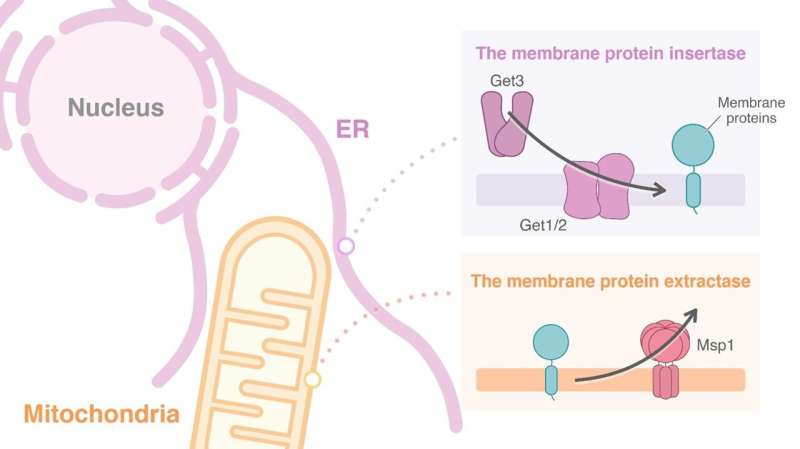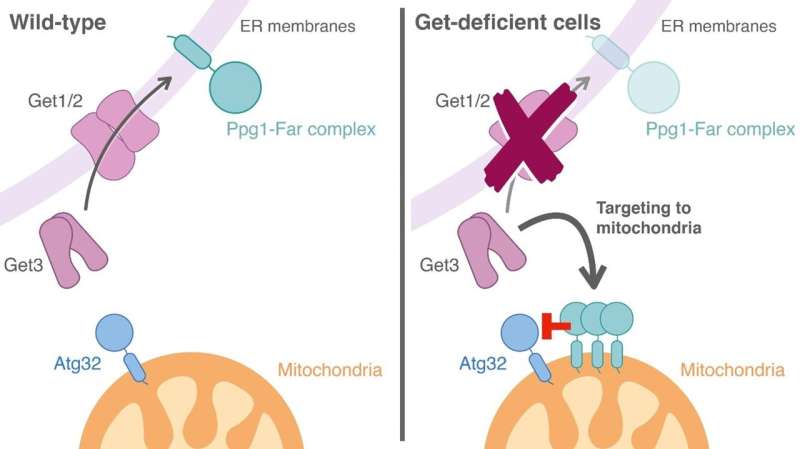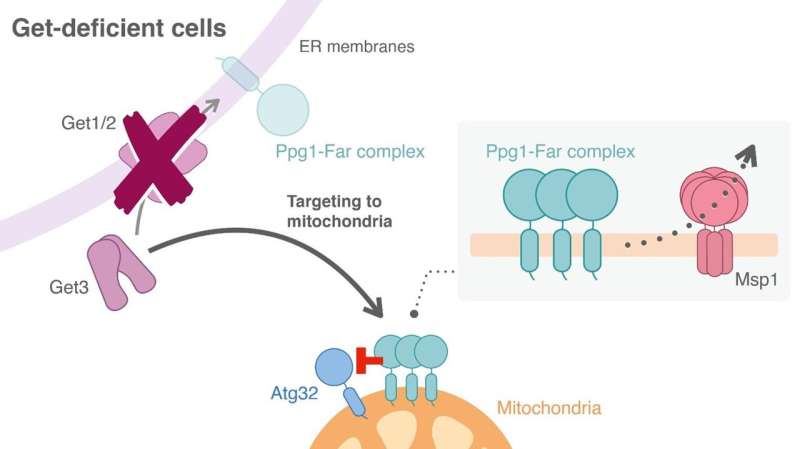This article has been reviewed according to Science X's editorial process and policies. Editors have highlighted the following attributes while ensuring the content's credibility:
fact-checked
trusted source
proofread
Breakthrough discovery in mitochondrial regulation

Researchers from Osaka University identify a system known as the "GET pathway" as essential for efficient regulation of the numbers of energy-producing mitochondria
A process known as mitophagy is responsible for the removal of mitochondria, the energy-producing parts of a cell. This occurs if they are defective, or to regulate their numbers. A protein anchored in the mitochondrial surface, called Atg32, promotes this process when it interacts with another protein, Atg11. Modification of Atg32 by phosphorylation—the attachment of a phosphate group—stabilizes the interaction between Atg32 and Atg11. The process by which this phosphorylation is regulated was unknown, but now a group from Osaka University has shown that a system known as the GET pathway is required for efficient mitophagy.
Mitophagy requires phosphorylation of Atg32 and a stable interaction between the Atg32 and Atg11 proteins. Mitophagy is suppressed by the action of a protein complex called the Ppg1–Far complex. This acts to reduce Atg32 phosphorylation and interaction with Atg11, and thus suppresses mitophagy.
Proteins located in membranes within the cell must be targeted to their appropriate destinations to maintain the functionality of the different cellular compartments. The GET pathway is responsible for inserting membrane proteins into the endoplasmic reticulum, which is a continuous and dynamic membrane system within the cell. When this pathway is disrupted, proteins can become predominantly inserted into the outer mitochondrial membrane instead.

The team first found that cells lacking the GET pathway showed reduced mitophagy. "This phenotype was rescued when cells lacked both the GET pathway and the Ppg1–Far complex," explains first author Mashun Onishi, "indicating that the reduction in mitophagy that we observed is related to the activity of the Ppg1–Far complex."
"We then went on to show that the GET pathway is responsible for tethering the Ppg1–Far complex at the endoplasmic reticulum membrane," explains senior author Koji Okamoto, "preventing it from interacting with Atg32 to suppress mitophagy, thus allowing Atg32 activation and consequent interaction with Atg11." In the absence of the GET pathway, however, the Ppg1–Far complex is instead targeted to the outer mitochondrial membrane, where it acts to suppress the process of mitophagy.

A protein called Msp1 acts to remove non-mitochondrial proteins from the mitochondrial membrane that have been located there. The team found that disruption of both GET and Msp1 resulted in more severe defects in mitophagy. This suggests that Msp1 might be responsible for removing incorrectly excessively localized Ppg1–Far from the mitochondria and thus maintaining the required levels of mitophagy.
Defects in the process of mitophagy can lead to cell death and have been implicated in aging and Alzheimer's Disease. This work greatly increases our understanding of mitophagy and opens avenues for future research with a significant impact on human health.
The article, "The GET pathway serves to activate Atg32-mediated mitophagy by ER targeting of the Ppg1-Far complex," was published in Life Science Alliance.
More information: Mashun Onishi et al, The GET pathway serves to activate Atg32-mediated mitophagy by ER targeting of the Ppg1-Far complex, Life Science Alliance (2023). DOI: 10.26508/lsa.202201640
Provided by Osaka University




















